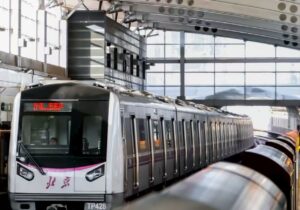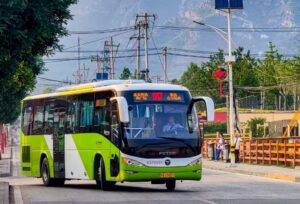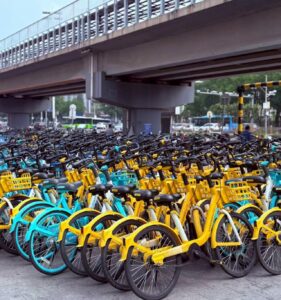Beijing Transportation Guide for International Travelers (2025)
Beijing's traffic ecology
Beijing presents a dynamic transportation ecosystem where ancient pathways intersect with cutting-edge mobility networks. As one of the world's great capitals, its scale can initially challenge visitors—yet beneath the apparent complexity lies a highly organized system designed for efficient urban navigation.
This guide deciphers Beijing's transit logic through the lens of international travelers. You'll discover not only operational protocols for subways, taxis, and bicycles but strategic frameworks to transform necessary movement into authentic cultural encounters.
Core Transportation Modes
-
Subway System

Operational Advantages
Beijing's subway remains the most reliable transit option, with trains arriving at 2-3 minute intervals during peak hours. All stations feature color-coded bilingual signage (English/Chinese) and automated English announcements. For visitors targeting major attractions, the system provides direct station access within 500 meters of sites like the Forbidden City (Tian'anmen East Station, Exit B) and the Summer Palace (Beigongmen Station).
Critical Usage Guidelines
-
Payment Integration: International travelers should prioritize Alipay for fare payments. Activate the subway QR code through Alipay's "Transport" module (path: App Home → "Transport" → Select "Beijing Subway"). Those preferring cash may purchase single-journey tickets from automated machines accepting ¥5/¥10 notes—note that machines at peripheral stations may lack English interfaces.
-
Peak Hour Navigation: Between 7:00-9:00 and 17:00-19:00 on weekdays, Line 1 (red) and Line 10 (blue) experience severe congestion. Mitigation strategies include boarding at transfer hubs like Wangjing West (Line 15) where seating availability increases by 60%.
-
Security Protocols: Mandatory baggage screening operates at all entrances. Power banks below 20,000mAh are permitted, while liquids in containers exceeding 100ml require inspection.
-
Taxis and Ride-Hailing Services
Traditional Taxi Operations
Licensed taxis display illuminated "北京TAXI" roof signs and should activate meters upon boarding. Visitors should prepare printed Chinese addresses of destinations—most hotels provide location cards for this purpose. While electronic payments are increasingly common, maintaining ¥20-50 in small bills remains prudent for older vehicles. Always request the printed receipt containing the driver's ID and plate number for potential disputes.
Ride-Hailing Optimization
The DiDi International app (iOS/Android) offers superior functionality for non-Mandarin speakers. Key features include:
-
Real-time English navigation during rides
-
Pre-trip fare estimates with toll inclusions
-
"Comfort" vehicle tier guaranteeing English-speaking drivers (add ¥15-20 premium)
For airport transfers, utilize the flight number synchronization function to automatically adjust pickup timing during delays.
-
Public Buses
unique advantage
Public buses serve niche scenarios where subway access proves impractical, particularly for:
-
Overnight airport transfers (e.g., Night Line 7 to Wangfujing)
-
Scenic corridor exploration (Route 5 along Qianmen's historic district)
-
Direct inter-attraction shuttles (e.g., 877 Express to Great Wall)
Essential protocols
-
Dual QR Scanning: Activate Alipay's bus code before boarding and re-scan upon alighting to avoid overcharging under the distance-based fare system.
-
Alighting Procedure: Press red stop buttons prominently installed near windows approximately 500 meters before your destination. Announcements remain Mandarin-only, necessitating Baidu Maps for real-time location tracking.
-
Shared Bicycles
System Selection Criteria
Meituan Bike (yellow) requires passport verification but imposes no deposit, while Hello Bike (blue) accepts international credit cards with a ¥199 refundable deposit. Registration necessitates:
-
Passport photograph upload
-
Chinese phone number verification (use hotel number)
-
GPS-enabled device location permissions
Operational Boundaries
Permitted zones include designated bicycle lanes in hutong districts and park peripheries. Strictly avoid restricted areas within 1km of Tian'anmen Square and subway station exits—violations trigger ¥20 repossession fees and account suspension. Optimal usage windows are 9:00-11:00 and 14:00-16:00 when air quality typically improves.
Scenario-Based Intelligent Transit Combinations
-
Airport-to-City Transfers
-
Cost-Effective Protocol:Board the Airport Express train (clearly signed from arrival halls) to terminal stations:
-
Capital Airport → Dongzhimen Station (25 mins, ¥25)
-
Daxing Airport → Caoqiao Station (35 mins, ¥35)Then transfer to subway lines: Dongzhimen connects to Lines 2/13; Caoqiao to Lines 10/19. Total journey time: 50-65 minutes.
-
-
Group Efficiency:Pre-book DiDi Comfort vehicles via flight number synchronization. Expect ¥180-220 fares including tolls for 4 passengers—30% cheaper than airport taxis.
-
Urban Attraction Circuit Navigation
For destinations within the 4th Ring Road:
-
Utilize subway for core distances exceeding 3km
-
Complete final-mile connections via shared bicycles where pedestrian infrastructure permits
-
Reserve taxis only during inclement weather or when carrying bulky items
Critical calculation: When traveling in groups of 3-4, ride-hailing often proves more economical than cumulative subway fares for sub-5km journeys (e.g., ¥12 DiDi fare vs 4x¥4 subway tickets).
-
Night Mobility Management (Post-23:00)
Prioritize services in this sequence:
-
DiDi International with 20% night surcharge—enable "Share My Ride" function
-
Night Buses (routes prefixed "夜/Ye") operating hourly along arterial corridors
-
Hotel-arranged cars despite premium pricing (typically 50% above DiDi)
Note: Exercise heightened caution with street-hailed taxis after midnight, particularly near Sanlitun nightlife districts where improper metering incidents increase by 40%.
Essential Operational Toolkit
-
Payment System Integration
International Visa/Mastercard linked to Alipay covers 90% of transit scenarios. Maintain ¥200-300 cash for:
-
Bus routes in remote districts (e.g., Great Wall access shuttles)
-
Traditional market vendors and hutong eateries
-
Taxi fare contingencies (approximately 15% remain cash-exclusive)
-
Critical Digital Applications
-
Baidu Maps: Superior to Google Maps for real-time transit data. Search using pinyin (e.g., "Gugong" for Forbidden City) + "by bus/subway".
-
DiDi International: Enable "Emergency Contact" settings under account preferences.
-
Microsoft Translator: Download Mandarin offline package for subway station navigation.
-
Safety and Contingency Protocols
-
Medical Emergencies:United Family Hospital (24hr English: +86 10 5927 7120)SOS International (+86 10 6462 9112)
-
Transit Disputes:Dial 12328 → Press 2 for English → Provide taxi receipt details
-
Lost Documentation:Contact nearest Police Station (派出所) with passport copy—hotel concierges assist with location guidance
Pre-Arrival Preparation Framework
Phase 1: Digital Setup (72+ Hours Pre-Travel)
-
Install Alipay → Bind international card → Activate Transit QR
-
Register DiDi International → verify payment method
-
Download offline resources:
-
Beijing Subway Map (PDF from bjsubway.com/en)
-
Mandarin translation pack for Microsoft Translator
-
Phase 2: Physical Preparation
-
Currency: Obtain ¥1,000 in ¥10/¥20 bills (larger denominations often rejected)
-
Documentation:• Color photocopy of passport ID page• Hotel address card in Chinese characters• Printed emergency contact sheet
Phase 3: First-Night Strategy
Upon airport arrival:
-
Purchase local SIM at airport kiosk (China Unicom: ¥150/30GB monthly)
-
Activate mobile payment at 7-Eleven via small purchase
-
Test DiDi service with short ride to airport hotel
May your navigation be seamless, your explorations profound, and every transit choice deepen your connection to this ancient-yet-forever-new metropolis!



